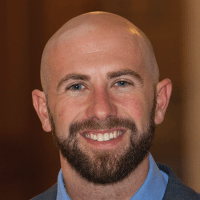 Moed
Moed
 Hunley
Hunley
Literary giant Kurt Vonnegut grew up in Indianapolis, the city that now honors his legacy with the Kurt Vonnegut Museum and Library. Founded in 2008, the museum aims to “champion the legacy of Kurt Vonnegut, the principles of free expression and common decency.”
The museum moved into its “forever home” at 543 Indiana Ave. in 2019. The landmark building houses a wide range of Vonnegut’s personal items, including his typewriter and Purple Heart medal, as well as exhibits on his works and other veteran artists.
Vonnegut’s upbringing in the city informed many of his works, which included 14 novels, five plays and five works of nonfiction, among others. As he famously wrote in “Cat’s Cradle,” “I don’t know what it is about Hoosiers. But wherever you go, there is always a Hoosier doing something very important there.”
NCSL spoke with very important Hoosiers Sen. Andrea Hunley (D) and Rep. Justin Moed (D), whose respective districts encompass the museum, about visiting the facility and the lasting impact of its namesake novelist in his hometown.
What does the Vonnegut museum mean to your district?
Hunley: People love the Vonnegut family here in Indianapolis, and it was really exciting when the museum opened in its new location to have this dedicated space that’s on Indiana Avenue.
Indiana Avenue is a diagonal avenue that cuts through the city that was home to a thriving Black music and business scene. They chose Indiana Avenue because Kurt Vonnegut was such a social justice warrior. He worked hard to fight racism and really celebrated and supported Black folks in the community.
Moed: I am a Vonnegut fan, and we’re really proud to have the museum in our community and be able to celebrate such a great author of American fiction from Indianapolis. The city has been working hard to revitalize these cultural districts. It’s on the Indiana Avenue corridor where there’s a lot of rich history and a university nearby. I think all of that collaboration works together really well. It’s a great place for people to be able to come.
What stands out? What are your favorite parts of the museum or favorite exhibits?
Hunley: You just really get a sense of what Vonnegut was like as a human. He was a whole human who was deeply flawed. He was depressed and kind of a cranky old man, but also had this big heart for the environment, environmental justice and many other things.
There’s also an event space in there, which is cool, and there’s a classroom where they do writer’s projects, especially for kids from underserved parts of the community to come and dig in and do creative writing. The space does a great job of bridging the past with not just the present but the future of writers in Indiana.
Moed: The guides. On the tour, they’re so passionate about Vonnegut’s work and the museum itself. They’re so proud of it. They really make the experience.
What does Kurt Vonnegut mean to your district today?
Hunley: We’ve been talking a lot about freedoms, and a lot about the freedom to write and the freedom to read, and the museum has been thrust into the spotlight around those issues, even more now than they were five or 10 years ago, and so they’re even more relevant now than they have been really in the past couple of decades. And they’ve been leading these conversations.
He created this apology to anyone who comes after him: “We could have saved the world, but we were just too damned lazy.” I think that every generation, we could save the world. But what is it that’s stopping us? I think about that a lot.
Are there any other Vonnegut-related sites or attractions in your district that people should check out if they’re fans?
Moed: The Red Key Tavern was known as a hangout of his. It’s an old dive bar that’s a good spot to go to. A lot of the restaurants and bars in the downtown community have really taken him on. There’s a giant mural of him in the Mass Ave neighborhood, then we have a famous restaurant, Bluebeard, that’s named after one of his books, and there are a lot of restaurants and bars that have cocktails and other things named for him. I think that’s neat to see, because not everyone knows he’s from here. Even people who are from here don’t know, so to see that he’s having a renaissance in the city of being known and his works being known, I think that’s great to see.
Which Vonnegut books have you read? What are your favorites?
Hunley: I was a high school English teacher, which makes me that much more excited and connected to Vonnegut’s work. I’ve read “Slaughterhouse-Five,” “Bluebeard,” “Player Piano,” “Breakfast of Champions.” I really like to teach “Slaughterhouse-Five,” so that’s one of the reasons why I enjoy that book.
A lot of times, when students think about literature that was written long ago, they wonder how will it connect? I like that there’s a lot of technical pieces. We can talk about allegory, we can talk about extended metaphor, we can talk about all of these literary elements, but then they’re also talking about challenging power. And I think that’s really cool, so I like to talk with students about that.
Moed: “Bluebeard,” “Breakfast of Champions,” those are great. “Cat’s Cradle.”
What else is great about your district? What else would you tell visitors to see?
Hunley: My district is in the 15th largest city in our entire country, and it really is a special place. It’s a very walkable city, and we’ve got great sports teams, but we also have a thriving food scene. There are a lot of really great restaurants to come and check out as well. Of course, you have to come for the Indy 500. It is only the greatest sporting spectacle in the entire world. You’ve got millions of people. It’s wild.
Moed: The whole Indiana Avenue corridor. Beyond the Vonnegut museum being there, the Madam C.J. Walker Theatre is there. Anybody that is excited about her or has seen the Netflix series (“Self Made”) that they did on her and her life and the impact that she had on the African-American community and the history that’s in that neighborhood, it’s certainly worth going and seeing the theater and experiencing Indiana Avenue.
“My District” gives NCSL members a chance to talk about life in the places they represent, from high-profile events and destinations to the fun facts only the locals know. The responses have been edited for length and clarity.
Eric Peterson is a Denver-based freelance writer.